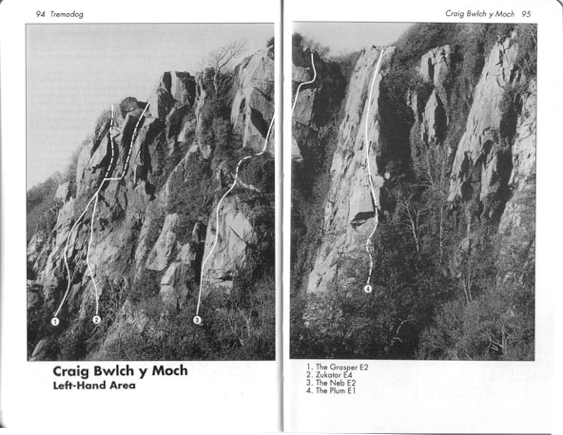There was an interesting thread on UKClimbing Forums last week about the Climbers’ Clubs guides. One of the main points to come out of the discussion was that the Climbers’ Club continue to produce guidebooks without route numbers. On the thread John Wilson states:
“These (numbers) make sense in guides where all or nearly all routes are shown on topos and where the topos are on same spread. We are thus using numbers in Portland and (as previously) in Southern Sandstone. Where this (as here – Wye Valley Guide) is not the case, keys have to be superimposed on the diagrams and text numbers are then totally pointless; they are also visually unattractive, they disrupt the left alignment of route names, and they add yet another numeral statistic to the lengths, grades and dates of the route-title lines.”
The discussion revolved around a sample download of the Wye Valley guide, available here from the Climbers’ Club site.
I actually think that route numbers become even more important when routes and diagrams are not on the same spread and here is why: (some of this was posted on the thread but I have expanded on it here a bit).
– Routes may appear on a map, may appear on a photo-topo, may appear on both, or neither.
– When you are looking at the route text (the first port of call for most) you have no idea where, or if, there is a diagram or map.
– So you start turning pages to look for one, and eventually come across a diagram.
– That diagram has some route names (all of which need reading of course) but not yours. So now what do you do?
– One thing you could do is turn more pages to look for another diagram, or you could turn back to you route to see if you recognise a route name near your route.
– You will need to read all the route names in order to locate which block of routes is covered on the diagram, but this block may be further to the right so you won’t find them without extensive further searching.
– If you do locate this block of routes you may know which way you should turn the pages to see if there is a diagram.
– Eventually you may find a diagram, or a plan map, but you will almost certainly have flicked back and forth through the guide several times trying to identify the block of routes covered by the topo/map and spending ages reading route names and trying to remember if they were the ones on the diagram you had found.
Now here’s how the same procedure works with consistent route numbers:
– the route you are interested in is route number 12 so you try and find a diagram.
– you turn pages and find one but it starts at route 20 so you know your route isn’t there straight away with one quick look, and you also know that, if there is a diagram, it is the other way in the book.
– You find another diagram either with your route, or with routes numbered up to something less than 12 in which case you know that your route doesn’t have a diagram and you have only flicked through a few pages.
As a practical example of a Climbers’ Club guide where the addition of numbers would have been a great help, consider the 2000 Tremadog guide. Tremadog is a notoriously difficult crag to locate the starts of routes owing to the trees, however you can usually spot the top sections from below on the road by Craig Bwlch y Moch. On page 94 95 of the Tremadog guide is the following photo-diagram:
This diagram has 4 routes listed on it but it actually covers 21 routes between The Grasper and The Plum, and a few more to the right as well. The route the Plum is actually 6 pages away from the diagram. What this diagram in its current state tells us is the rough location of 4 routes. If you want to do a route in this area that isn’t marked on the diagram then you need to read and memorise the route names of the four routes that are featured and try and related them using the text to your route – that is 6 pages of text!
With the simple addition of numbers – Grasper as route 1, and The Plum as route 21, you can easily tell what the spread of the diagram is without memorising any route names. The addition of a few annotations to say which routes started in which area would make the diagram even more useful and with route numbers you could do this very concisely. For example: the clean wall to the left of The Plum could be indicated as being the starting point for routes 17 to 20. At a crag like Tremadog this is useful information, particularly for the hundreds of people each year who want to do the route Christmas Curry.
However you end up actually using them, I can see no way that the addition of numbers in any guide can be regarded as “totally pointless”. Numbers help to relate routes to each other and they help to relate routes to diagrams and topos. They do not add unnecessary clutter if you design the page correctly and to omit them on the grounds of page design is about as daft as omitting the technical grade of a route because you couldn’t find anywhere to write it in your current page layout.


